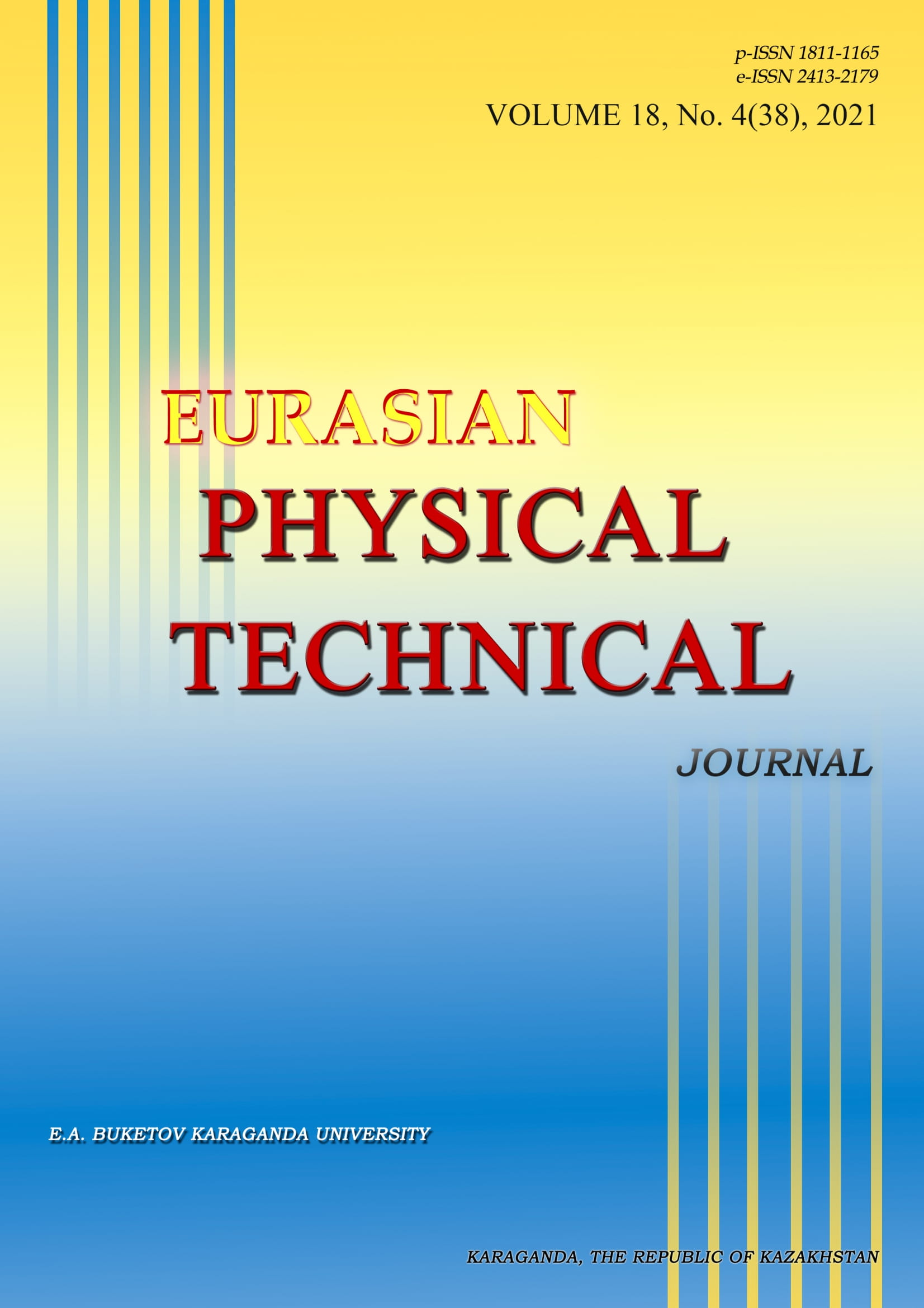Исследование влияния изменения разности прикладываемых потенциалов на свойства тонких пленок CDSE:NI
DOI:
https://doi.org/10.31489/2021No4/20-28Ключевые слова:
легирование, CdSe, фотокатализ, тонкие пленки, скорость реакцииАннотация
Данная работа посвящена исследованию эффективности применения эффекта допирования никелем тонких пленок на основе CdSe с возможностью вариации структурных и оптических свойств, обусловленной изменением фазового состава пленок. В качестве метода получения пленок был выбран метод электрохимического восстановления ионов металлов из водных растворов электролитов. Варьирование разности прикладываемых потенциалов было использовано для получения пленок с различными характеристиками. Для характеризации свойств и динамики их изменений были выбраны методы атомно-силовой микроскопии, энергодисперсионного анализа и рентгеновской дифракции. Прочностные механические свойства пленок были исследованы с применением метода индентирования. В ходе проведенных экспериментов получены зависимости изменения структурных, оптических, прочностных характеристик синтезированных пленок в зависимости от условий получения. Фотокаталитические испытания на определение скорости и эффективности разложения органического красителя Родамина В показали, что пленки в составе которых преобладает фаза NiSe обладают наибольшей перспективностью применения в качестве фотокатализаторов.
Библиографические ссылки
"1 Liu Hao, et al. Enhanced photocatalytic capability of zinc ferrite nanotube arrays decorated with gold nanoparticles for visible light-driven photodegradation of rhodamine B. Journal of materials science. 2016, Vol. 51, No.12, pp. 5872 – 5879.
Alshammari A., Bagabas A., and Assulami M. Photodegradation of rhodamine B over semiconductor supported gold nanoparticles: the effect of semiconductor support identity. Arabian Journal of Chemistry. 2019, Vol. 12, No. 7, pp. 1406 – 1412.
Sangami G., Dharmaraj N. UV–visible spectroscopic estimation of photo-degradation of rhodamine-B dye using tin (IV) oxide nanoparticles. Spectrochimica Acta Part A: Molecular and Biomolecular Spectroscopy. 2012, Vol.97, pp. 847 – 852.
Parvaz S., Rabbani M., Rahimi M. Fabrication of novel magnetic ZnO hollow spheres/pumice nanocomposites for photodegradation of Rhodamine B under visible light irradiation. Materials Science and Engineering: B. 2021, Vol 263 pp. 114863.
Kozlovskiy A.L., Alina A., Zdorovets M.V. Study of the effect of ion irradiation on increasing the photocatalytic activity of WO 3 microparticles. Journal of Materials Science: Materials in Electronics. 2021, Vol. 32, No. 3, pp. 3863 – 3877.
Kozlovskiy A., et al. The study of the applicability of ionizing radiation to increase the photocatalytic activity of TiO 2 thin films. Journal of Nanostructure in Chemistry. 2020, Vol. 10, No. 4, pp. 331 – 346.
He M. Q., et al. Synthesis of molecularly imprinted polypyrrole/titanium dioxide nanocomposites and its selective photocatalytic degradation of rhodamine B under visible light irradiation. Express Polymer Letters. 2014, Vol 8, No. 11, pp 850–861.
Larowska D. et al. Graphene oxide functionalized with cationic porphyrins as materials for the photodegradation of rhodamine B. The Journal of Physical Chemistry C. 2020, Vol. 124, No. 29, pp. 15769-15780.
Jadhav S.A., et al. Magneto-structural and photocatalytic behavior of mixed Ni–Zn nano-spinel ferrites: visible light-enabled active photodegradation of rhodamine B. Journal of Materials Science: Materials in Electronics. 2020, Vol. 31, pp. 11352-11365.
Fattahimoghaddam H., Mahvelati-Shamsabadi T., Lee B.-K. Efficient photodegradation of rhodamine B and tetracycline over robust and green g-C3N4 nanostructures: supramolecular design. Journal of Hazardous Materials. 2020, Vol. 403, pp. 123703.
Il’chuk, G. A., et al. Peculiarities of the optical and energy properties of thin CdSe films. Optics and spectroscopy. 2020, Vol. 128, No. 1 pp. 49-56.
Milonakou-Koufoudaki, K., et al. Natural dyes in hybrid chalcogenide multi-layer thin films. Bulletin of Materials Science. 2020, Vol. 43, No. 1, pp. 1 - 11.
Hamann, Kathryn R., et al. Optically tunable mesoscale CdSe morphologies via inorganic phototropic growth. Journal of Materials Chemistry C. 2020, Vol. 8, No. 36, pp. 12412-12417.
Chauhan P., et al. Superior electrochemical activity of CdSe thin film by chromium substitutional doping. Journal of Alloys and Compounds. 2021, Vol. 862, pp. 158016.
Shelke N.T., Karle S.C., Karche B.R.. Photoresponse properties of CdSe thin film photodetector. Journal of Materials Science: Materials in Electronics. 2020, Vol. 31, No. 18, pp. 15061-15069.
Lohitha B., Thanikaikarasan S., Roji Marjorie S. Growth and characterization of CdS and Fe doped CdS thin films through electrochemical route. Materials Today: Proceedings. 2020, Vol. 33, pp. 3068-3071.
Patil N.M., et al. Structural, optical and electrical properties of spray-deposited Fe-doped nanocrystalline ZnS0.2Se0.8 thin films. Phase Transitions. 2021, Vol. 94, No. 6–8, pp. 493–510.
Han Chong et al. Carbon Dots Doped with Ni(OH)2 as Thin-Film Electrodes for Supercapacitors."" ACS Applied Nano Materials. 2020, Vol. 3, No.12, pp. 12106-12114.
Abdulwahab A.M., Asma'a Ahmed A.L.-A., Ahmed A.A.A. Influence of Ni-Co dual doping on structural and optical properties of CdSe thin films prepared by chemical bath deposition method. Optik. 2021, Vol. 236, pp. 166659.
Tan, Wenyu, et al. Nucleation and growth mechanisms of an electrodeposited Ni–Se–Cu coating on nickel foam. Journal of Colloid and Interface Science. 2021, Vol. 600, pp. 492-502.
Omarova, A., et al. Study of the influence of synthesis conditions on stoichiometry and the properties of nanostructured CdSe thin films. Journal of Materials Science: Materials in Electronics. 2020, Vol. 31, No. 15, pp. 12756-12764.
Alasvand A., Kafashan H. Investigation the effect of Pb incorporation on the surface characterizations of electrodeposited CdSe nanostructures. Journal of Alloys and Compounds. 2020, Vol. 817, pp. 152711.
Ayal, A.K., et al. Sensitization of TiO2 nanotube arrays photoelectrode via homogeneous distribution of CdSe nanoparticles by electrodeposition techniques. Journal of Physics and Chemistry of Solids. 2020, Vol. 153, pp. 110006.
Shaikh A.V., et al. Electrodeposition of n-CdSe/p-Cu2Se heterojunction solar cells. Engineered Science. 2020, Vol. 13, pp. 79-86.
Saha S., et al. Electrodeposition Fabrication of Chalcogenide Thin Films for Photovoltaic Applications. Electrochem. 2020, Vol. 1, No.3, pp. 286-321.
Gullu H.H., et al. Temperature effects on optical characteristics of CdSe thin films. Materials Science in Semiconductor Processing. 2021, Vol. 123, pp. 105559.
Erturk K., et al. Investigation of structural, spectral, optical and nonlinear optical properties of nanocrystal CdS: Electrodeposition and Quantum Mechanical Studies. Optik. 2021, Vol. 243, pp. 167469.
Thanikaikarasan S., et al. Physical, chemical and optical properties of CdSe and CdSe: Zn thin films obtained through low cost electrochemical route. Materials Today: Proceedings. 2020, Vol. 21, pp. 73-77.
Zhang Y., et al. Alkaline electrolyte: toward high-quality CdTe films with the assistance of strong complexing agent and organic base. CrystEngComm. 2018, Vol. 20, No. 1, pp. 8-11.
Zyoud A., et al. Electrochemically and chemically deposited polycrystalline CdSe electrodes with high photoelectrochemical performance by recycling from waste films. Materials Science in Semiconductor Processing. 2020, Vol. 107, pp. 104852.
"















